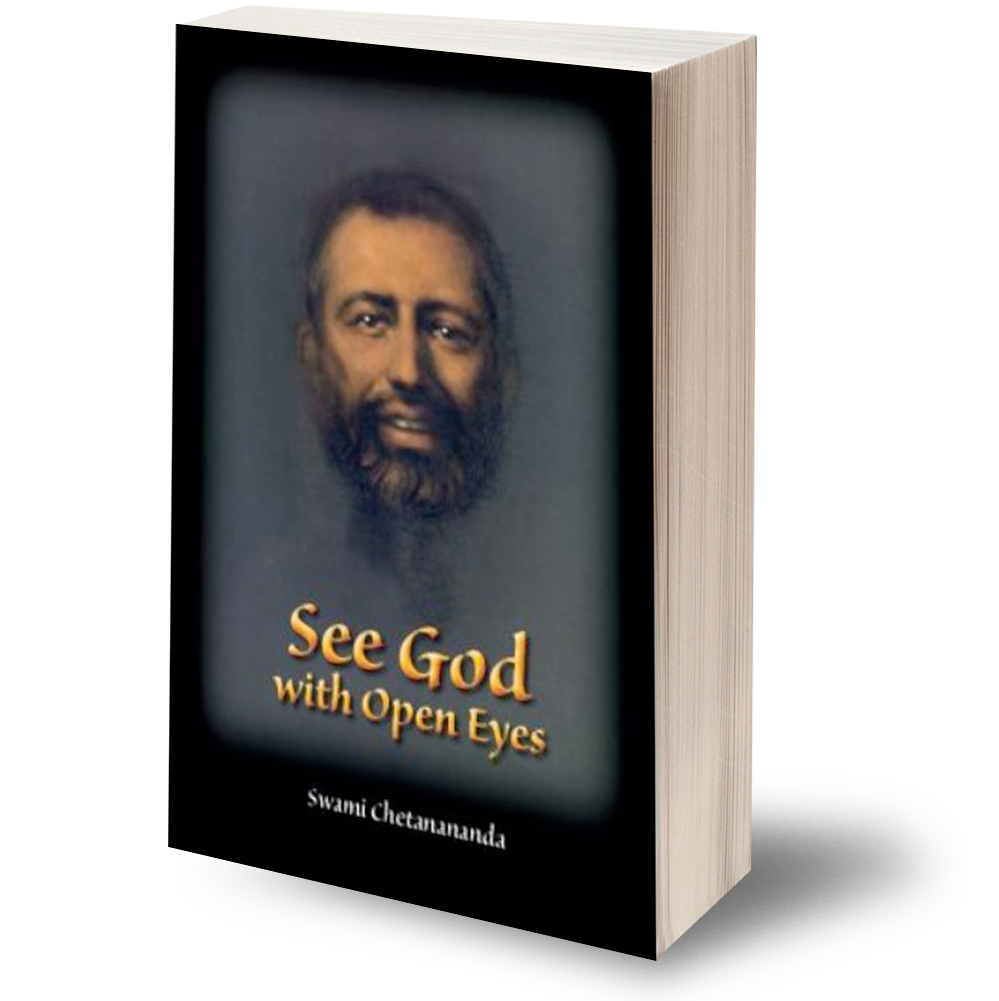A short introduction from The Vedanta Society of St. Louis bookshop’s web page:
This title raises several questions: Does God have a form? Can we see God as we see other objects and beings in this world? Can we hear or touch God? Ramakrishna answered these questions with his words and through his life — and many of those answers are collected in this book.
When God takes a human form, we want to see how that avatar lives, acts, talks, walks, laughs, cries, eats, and sleeps like other human beings. This book depicts how lovers of God can establish and deepen their relationship with Ramakrishna through prayer and meditation, and that strong bond makes them feel safe, secure, and saved.
Book Review
See God with Open Eyes
by Swami Chetanananda
480 pages, 42 illustrations
Review by Linda Johnsen

In the galaxy of world spirituality, Bengali mystic Ramakrishna Paramahamsa (1836-1886) was a supernova. On fire with devotion for the great Hindu goddess Kali, he nevertheless demonstrated in his own actions that ultimately all religious faiths lead to the Divine—a radical concept in the 19th century. The Gospel of Sri Ramakrishna, a compendium of many of the Master’s sayings, is widely considered one of the greatest spiritual masterpieces of the modern era. In 1893 Ramakrishna’s disciple Swami Vivekananda delivered his teachings to Europe and America, igniting the yoga movement in the West.
In See God with Open Eyes, Swami Chetanananda has collected gems of wisdom from the great Master in a work specifically designed to galvanize our own spiritual experience. Meditation and visualization: what is the difference and is one more valuable than the other? Should meditators focus on the eyebrow center or the heart? Why do yogis chant the syllable Om? Which lifestyle is more conducive to spiritual growth: living with one’s family or withdrawn from worldly life? Is there a God or is the ultimate reality distant and impersonal? How should we pray and what should we pray for if we aspire to feel the living presence of the Divine as powerfully as Ramakrishna did? What practices did the great Master himself perform to attain realization of the Divine? In this book Ramakrishna becomes our spiritual advisor, guiding us in his unfailingly charming and down-to-earth manner.
When we focus intently on specific spiritual qualities consistently over a period of time, we acquire those characteristics. Here we discover how we can meditate on Ramakrishna’s image, his inspiring words, deeds, divine qualities, and even on the sites where Ramakrishna lived and worshiped, to connect with the great saint’s wisdom and grace. As Swami Chetanananda points out, the great Master’s mind was extraordinarily pure and God-centered. By meditating on the Master, we invoke that purity and devotion in ourselves.
It goes without saying that today we are living in a time of world crisis. Now more than ever the men and women of this beleaguered planet need to awaken spiritually so that we can realize our fundamental unity. Ramakrishna called on all of us to set aside our religious and cultural differences in order to come together in celebration and service, in mystical enlightenment.
Swami Chetanananda is one of the world’s foremost authorities on Ramakrishna and his tradition. He has authored, edited, and translated a host of inspiring yet comprehensive books, among them Ramakrishna as We Saw Him, They Lived with God, God Lived with Them, How to Live with God: In the Company of Ramakrishna, and Sri Ramakrishna and His Divine Play.
In his own time Ramakrishna was an uneducated temple priest who earned barely five rupees a month. Today he ranks with Rumi, St. Francis of Assisi, and Kabir as a master whose words and living example continue to inspire millions. For readers new to Ramakrishna, this book is an inviting entry point to his amazing life story. For those who have already loved the Master for years, whether your eyes are open in daily activity or closed in meditation, See God with Open Eyes will accelerate your spiritual journey.
Linda Johnsen, author of Daughters of the Goddess: The Women Saints of India
